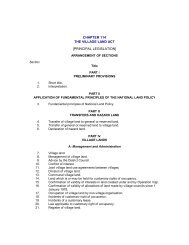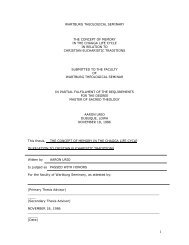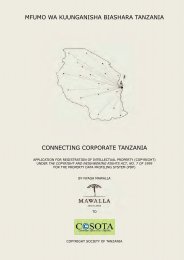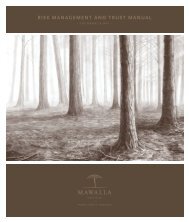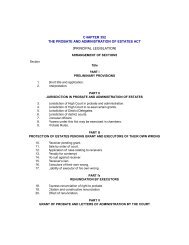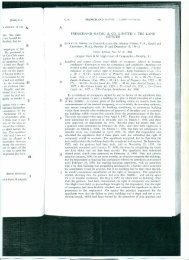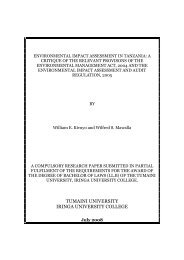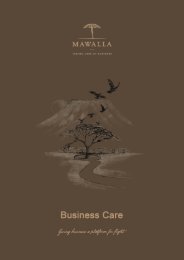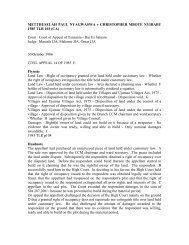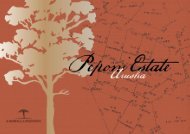MULBADAW VILLAGE COUNCIL AND 67 OTHERS v NATIONAL ...
MULBADAW VILLAGE COUNCIL AND 67 OTHERS v NATIONAL ...
MULBADAW VILLAGE COUNCIL AND 67 OTHERS v NATIONAL ...
Create successful ePaper yourself
Turn your PDF publications into a flip-book with our unique Google optimized e-Paper software.
necessary to make a decision on this aspect too. This is to the effect that NAFCO has alawful right of occupancy over the disputed areas.B Before coming to the decision on the issues, let us consider the defendant's evidenceon them. DW.1 Sadiki Omar Libembembe, an Administrative Officer with NAFCOtestified that in 1960 the Government started research into the possibilities of large scalegrowing of wheat in Hanang C District. He produced as exhibit D.1 a Plan made by theBritish Government's department of surveys and issued by the Ministry of Land andHousing. He stated that in 1969 the Kilimo Department started Bassotu Wheat Schemeand in the same year NAFCO was established by Act 17 of 1969. He D produced photocopies of the national development plans showing that the wheat projects in Hanang werepart and parcel of national development plans. On the question of how the projects wereimplemented vis-a-vis the peasants already in occupation of land in the marked areas hesaid this:E When we start a project the peasants are informed through the instruments of theGovernment and the Party. A letter is written from NAFCO Headquarters to the RegionalParty Secretary who was then also the F Regional Commissioner. He then spreads themessage to the villagers through the Katibu Kata, etc. The NAFCO Manager in the areaalso assists in the spread of the informationDW7 MAO Mwengamba, Manager of Mulbdaw wheat project, on this aspect had this tosay:G In the 1980/81 season we had to move people out. The procedure followed was toinform the Katibu Kata of the affected area. On 29.3.1979 I saw the Katibu Kata toinform him to move out the peasants who were in the area earmarked for expansion.H This witness went on to explain how NAFCO Officers held a meeting on 25.7.79 withthe Mulbadaw village authorities who were accordingly informed of the boundaries ofMulbadaw farm.I On the second facet of the defendant's defence a number of witnesses testified - themain one being one T.M. Hyera (DW2) of the Land Office at Arusha. According to thiswitness an application1984 TLR p20D'SOUZA Ag Jby NAFCO for 22,793 acres of land at Bassetu was approved by the Regional LandAdvisory A Committee and by its letter AR/R/1009/22 of 20.1.1973 to NAFCO theLand Office made a formal "offer" of a right of occupancy. There is no evidence onrecord that this offer of 20.1.73 was accepted and registered. Instead there is a request fora resurvey and division and new offers for smaller units. Accordingly another offer (Ex.D.16) was issued to NAFCO for the Mulbadaw area - B dated 29.7.1981. The same wasaccepted and fees were paid in August 1981. The offer document was signed by NAFCOin July 1981. The Right of Occupancy was for 99 years back-dated to 1.7.1979. CAt the end of the case for both sides the court specifically directed both counsel to submiton the applicability of Act 47/19<strong>67</strong> Land Acquisition Act. Both counsel, Mr. Jundu andMr Musei did so. Section 3 of the said Act authorizes the President to acquire land wheresuch land is required for any public purpose. S.4(2) provides: DWhere the President is satisfied that a corporation requires any land for thepurpose of construction of any work which in his opinion would be of public utility or inthe public interest or in the interest of the national economy, he may, with the approval,




